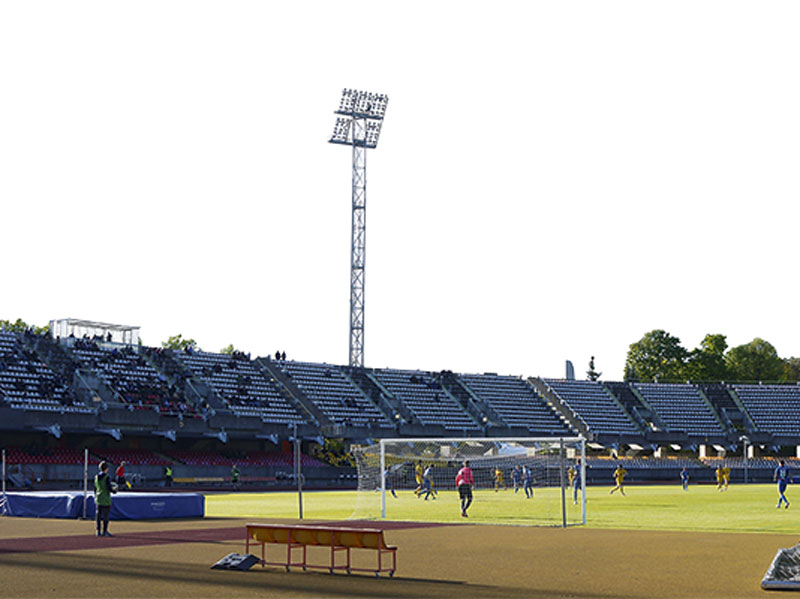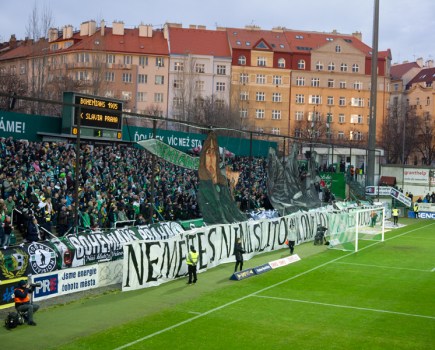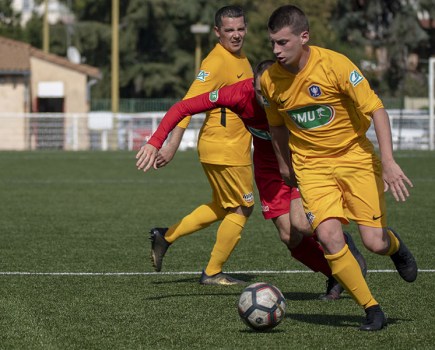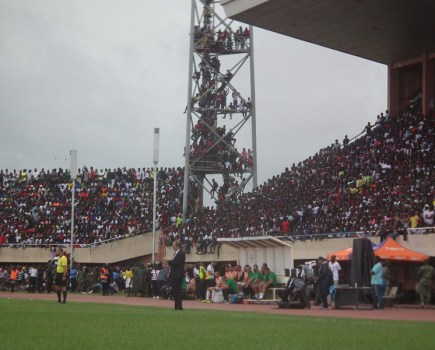Mind The Gap: The Haves Continue To Flourish At The Expense Of The Have-Nots
On the surface, European club football is thriving. In 2015, Europe’s clubs made aggregate profits of €1.5billion and attendances rose by 2.6million according to UEFA’s latest report. But beneath the sheen offered by those leagues that have colonised the television schedules there is a very different story.
Nearly half of the €8.2bn generated by Europe’s top-flight divisions came from the continent’s 30 biggest clubs. Yet between 2009 and 2015, average club revenue in Austria, Denmark, Greece, Holland, Norway, Portugal and Scotland either fell or increased only marginally.
UEFA acknowledges a “widening financial gap between the global super powers and other large clubs” and some countries are increasingly being left behind as interest in the club game dwindles.
Crowds fell in the top leagues of 17 UEFA members last season and some clubs cannot even charge on the gate. Stumbras in Lithuania, for example, simply ask for donations, while two thirds of the Armenian league let fans in for nothing.
Like many sports competitions, fixtures in the Armenian Premier League often get shifted to accommodate television schedules, yet broadcasters pay nothing for the rights and can even move kick-off times on the day of a game. No wonder many Armenian fans are losing interest in their own domestic competition.
Even in Azerbaijan, where the game is awash with oil cash, some top-flight clubs struggle to generate support. Inter Baku tried letting fans in for free. But when the crowd figures remained the same, the club went back to charging; money from 500 fans was better than no money at all.
Outside of the top leagues, clubs struggle to command a significant fee for TV rights, in part because the Premier League and La Liga have commandeered the attention of their fans.
“The biggest problem is the TV deal for the Premier League; it creates this massive gap,” says Antonia Hagemann, who is head of Supporters Direct Europe, which helps supporters take control of their own clubs.
TV money provides less than five per cent of revenue in 32 out of 54 European leagues and this has a major knock-on effect at clubs struggling to survive.
Outside of the top 20 leagues, 55 per cent of clubs are losing money. Of 393 clubs in these leagues, 91 of them spend at least €6 for every €5 they make. In Estonia and Georgia, that ratio is larger still, with clubs there spending €3 for every €2 they bring in.
“In a number of countries, profitability remains the exception rather than the rule,” UEFA notes dryly in its report.
Former Soviet bloc countries are particularly struggling and clubs routinely vanish. In the first two decades since independence, Lithuania lost 20 clubs.
In 2015 alone, three Latvian sides disappeared and there are now just six clubs in Armenian’s Premier League.
In the middle and lower reaches of the European club game, many clubs survive through the subsidy of money from UEFA competition. In Belarus and Croatia, UEFA money provided 45 per cent of revenue in 2015. In Andorra, Estonia, Gibraltar, Latvia, Malta, Montenegro and San Marino, club revenue is, on average, €400,000, or less.
For the players, taking part in European competition is often the only guarantee that they will get paid. This season, clubs appearing in the Champions League first qualifying round earned €450,000 regardless of their performance.
For the 44 clubs playing in the Champions League and Europa League qualifiers, UEFA payments contributed more than all other revenue sources put together.
This UEFA money often goes to the same handful of clubs. BATE and Dinamo Zagreb have been the sole Champions League representatives from Belarus and Croatia respectively over the last decade.
At the top end, Financial Fairplay may have curbed losses but it cemented the place of the top sides. And FFP only applies to clubs with a turnover of more than €5 million. Below this level, the losers are often the players, who are also beginning to walk away.
The 2016 Global Employment Report from footballers union FIFPro found that three quarters of players earn less than $4,000 a month and warned that “players are usually the first to see the downside of ‘jackpot economics’”, which basically means not getting paid.
In 2011, Laurentiu Petean won the Romanian league with his home-town club Otelul Galati, who went on to play against Manchester United at Old Trafford in the Champions League. At the age of just 29, according to a report in The Independent, he has retired and is doing odd jobs at a hotel in Germany, where he can earn more than as a player in Romania.
In 1986, the Romanian league provided the champions of Europe; now Steaua Bucharest – like so many former Soviet sides that once bestrode the continental stage – exist in name only.
As local leagues fail to attract attention from fans, television broadcasters and sponsors, players and clubs can fall prey to match-fixers. Tony Higgins, vice president of the European division at FIFPro, says: “Local matches lose credibility because of match-fixing so they start looking for credible matches to beam in. This stymies the commercial growth of these clubs.”
Unable to pay players, some club owners turn to match-fixers for income. FIFPro’s report found that players in lower-income brackets are up to three times more likely to be approached by fixers.
Gangsters are taking advantage of this financial weakness across Europe: from a Cypriot league so plagued by match-fixing that coaches who refuse to comply are sent bombs, to Bulgaria, where numerous club directors have been assassinated.
In 2015, the Latvian league lost three clubs to bans related to organised crime. They included former champions Daugava, whose 2013 Champions League qualifier with Swedish side Elfsborg was investigated for match-fixing.
The problem is that the financial gap is greater than ever. “There’s always been a gap between the bigger clubs but it’s about helping the middle class,” says Janis Mezeckis, who is the Latvian Football Federation’s secretary general.
At international level, the gap – on the field at least – is closing and analysis in late 2014 by The Daily Telegraph showed only 10 of the 593 European qualifiers in the previous year were won by a margin of six or more goals.
Euro 2016 and performances by the likes of Iceland suggest that trend is continuing, though some pundits have lamented the lowering of standards. So far in Europe’s 2018 World Cup qualifiers, only six games have been settled by six or more goals. Smaller European countries can find a way to compete at international level, albeit sometimes to the detriment of the entertainment level, but in the cash-dominated club game – even with the weaker sides taken out – thrashings are on the rise.
Given that there are currently four rounds of qualifiers prior to the Champions League group stage, a four-goal difference is probably a better gauge of a thrashing. In the 2016-17 group stage, four goals or more settled 14 games.
Games such as Bayern Munich’s 5-0 pasting of Rostov, Arsenal’s 6-0 romp over Bulgarian champions Ludogorets or Celtic’s 7-0 hiding by Barcelona are unlikely to attract neutrals on TV.
In the round of 16, 14 of the clubs are from England, France, Germany, Italy and Spain. That is the largest proportion of “market share” taken by the “Big Five” in the last five years, yet the European Clubs Association is resistant to change.
“Politics and commerce should not be the exclusive priority in football,” said ECA and Bayern chairman Karl-Heinz Rummenigge, without a hint of irony, in dismissing FIFA’s plans to expand the 2026 World Cup to 48 teams.
In his 2016 FIFA presidential election campaign, outsider Jerome Champagne railed against what he described as the “UEFA-ication” of FIFA and bemoaned the state of the European game. “Football in places like Georgia is already dead,” said Champagne. “People worry the Dutch clubs can never win the Champions League, but look at the gap in France?”
In 2015-16, Ligue 1 runners-up Lyon were 31 points adrift of champions Paris Saint-Germain but only 16 points off the relegation zone.
The Ligue 1 title race is closer this season, but PSG’s budget is inflated by Middle Eastern oil money and dwarfs its French peers.
Like PSG, Bayern are expanding abroad and have offices in New York and Shanghai, but German club revenues are much less than those in England – and the trend will only continue.
“German clubs talk about getting rid of the ‘50+1’ ownership rule, but even if they do that closing the gap [with the Premier League] will not be possible,” says Antonia Hagemann.
Only Spain are in a position to challenge.
At the Soccerex Global Convention in Manchester last September, representatives of La Liga made it clear that they were gunning for the Premier League in a crazy race for domination of the world’s football fans.
La Liga has 10 offices across the world, from Brussels and Singapore to two in China, and wants fans to split their loyalties between home teams and Spanish sides.
“Rising tides floats all boats,” said a hopeful Kathy Carter from Soccer United Marketing, which handles all marketing for North American football including Major League Soccer, at Soccerex.
In a nascent soccer market, MLS is expanding with 10 cities bidding for four new franchises, but this notion of split loyalties is not working among fans in Europe, where many weaker leagues are shrinking.
In 2012, the Kazak Premier League dropped from 14 to a dozen clubs. In 2013-14, Bulgaria’s First League dropped from 16 to 14 clubs and Croatia’s HNL went from 12 to 10 clubs. The next season, Albania’s Superliga was cut from 12 to 10 clubs and in 2015-16 Romania’s then 18-team Liga I dropped four clubs.
This season, the Premier League in Bosnia & Herzegovina was slashed from 16 sides to 12 and Lithuania’s A Lyga shrank from 10 to eight clubs.

Shrinking…this season Lithuania’s top flight has gone down from 10 to eight clubs
In countries where televised English, Spanish and, to a lesser degree, German football is ubiquitous, there are simply not enough fans to go around. In Georgia, where the Liga is being cut from 16 teams to 10, the biggest draw is El Classico.
Locals in Georgia are stuck in a time warp, back in May 1981, when Dinamo Tbilisi won the European Cup-winners Cup. To assemble a side capable of challenging even for a slot in the Europa League group stage these days would mean more than doubling Dinamo’s current budget. But if they took that gamble and lost, the club would probably go the way of 15-times Latvian Virsliga winners Skonto Riga, who went bust before Christmas 2016.
“Some of the smaller football associations acknowledge that things are not going right and are looking to engage with their supporters,” says Hagemann. “The Georgian and Romanian associations both got in touch with us to look at more progressive ways of running football clubs.”
One oft-mooted panacea has been the creation of cross-border leagues. They could, it is argued, act as an alternative to the Champions League or Europa League, generating more local interest.
The idea of an Atlantic League featuring clubs from Belgium, Denmark, Holland, Scotland and Sweden resurfaced after changes to the Champions League format made prior to Aleksander Ceferin being elected UEFA president last year.
A kick-off has been mooted for 2021 to coincide with the end of the next Champions League broadcasting cycle, but the idea has been raised ever since the formation of the G14 group of Europe’s richest clubs in 2000 without ever materialising.
“I don’t think there will be a lot of Dutch fans that will stay up to watch Ajax versus Copenhagen,” says FIFPro’s Dutch head
of communications, Raymond Beard.

Space…Zalgiris
fans in Lithuania
History suggests that Beard is right. Although UEFA has never approved attempts to create the Atlantic League, various other cross-border competitions have kicked off then vanished.
The Scandinavian Royal League won UEFA approval in 2004 and featured the likes of Brondby, Copenhagen and IFK Gothenburg, but was cancelled in 2007-08 due to high financial costs and unsold TV rights.
The Baltic League also kicked off that season, featuring the top four clubs from Estonia, Latvia and Lithuania, but that was stopped in 2011 due to fears it had been targeted by match-fixers.
In 2013, Aleksey Miller, the chairman of oil company Gazprom, proposed the Unified Football Championship (UFC) for leading Russian and Ukrainian clubs, including Gazprom-sponsored Zenit and 2009 UEFA Cup winners Shakhtar Donetsk. Perennial Belarusian title winners BATE reportedly supported the UFC, which was a throwback to Soviet times when places such as Armenia and Lithuania often had sides in the old Higher League.
Back then, clubs such as Ararat – Soviet League winners in 1973 and European Cup quarter-finalists a year later – and Zalgiris attracted strong local support as they were in effect national teams in countries without independence.
An ice hockey version of the UFC has been in operation since 2008. “Football is the most popular sport in Latvia except for the Kontinental Hockey League (KHL),” says LFF secretary general Janis Mezeckis.
The KHL comprises mostly Russian teams plus representatives from Belarus, Latvia and Kazakhstan, among others.
With Gazprom – a major UEFA sponsor – supposedly offering €1bn sponsorship, the Russian proposal would have been hard to ignore, but Miller’s close confidant, Russian premier Vladimir Putin, sanctioned a military occupation of the Crimean peninsula in Ukraine. That ended any involvement from Ukraine, but another cross-border competition produced a more significant influence.
A Balkan cross-border club basketball league, the Adriatic been staged since 2001-02 and features sides from Bosnia & Herzegovina, Croatia, Macedonia, Montenegro, Serbia and Slovenia.
In March 2015, the Croatian newspaper Vecernji list reported on plans for a Balkan league featuring 42 clubs from 13 countries in south-eastern Europe. But instead of producing a breakaway league, those countries came up with something potentially more dangerous to the elite clubs – the candidacy of Ceferin for UEFA president.
The Slovenian was elected a matter of weeks after the European Club Association – which declined to be interviewed for this article – had secured a deal guaranteeing four places in the group stage from 2018 to 2021 for the Spanish, English, Italian and German leagues.
The deal was agreed only weeks before Ceferin had warned of the need for more balance in European football.
In his campaign, the Slovenian also argued that “only representatives active in their respective national associations can be members of the UEFA executive committee”, which was a well-aimed dig at selfish club owners.
Finally, the disenfranchised – and in particular, those smaller countries who at one point in the evolution of the Champions League had even been excluded completely, along with the bankrupt eastern Europeans – had themselves a representative.
Ceferin‘s victory over Dutch opponent Michael Van Praag was a landslide, by 42 votes to 13, and involved some painful decisions that illustrated the depth of feeling involved.
Van Praag was Gibraltar’s portfolio holder during the British territory’s decade long attempt to join UEFA, but he did not receive their vote.
“It was very difficult as we have a lot of respect for Michael but something has to change,” says Gibraltar Football Association chief executive Dennis Beiso.
Iceland and Faroe Islands voted for Van Praag but most smaller countries – such as Luxembourg, Malta and San Marino – joined disenfranchised Eastern European countries to support Ceferin, while bigger nations such as Germany, Italy and Portugal also turned their back on Van Praag.
The English and Spanish, whose clubs dominate European football financially to such an unhealthy extent, voted for the Dutchman but the result was an overwhelming vote against the status quo.
Of UEFA’s 55 members, 23 have never had a club in the money-spinning group stages of the Champions League. At least 13 of those countries – and probably more – supported Ceferin. But the actual reality is that they now have even less chance of taking part.
Ceferin promised to renegotiate the Champions League deal but the bluster of a breakaway once again blew down the corridors of Nyon at the December 2016 UEFA ExCo meeting. A new Champions Path will offer greater protection to league winners, but the big countries emerged unscathed. “The new deal between the European Clubs Association and the Champions League will widen the gap,” says Hagemann.
Under Ceferin, UEFA promises there is “more rebalancing to come” but the European game stands on a precipice. Change is necessary but European football is surely more divided than ever.
This article first appeared in the March 2017 issue of World Soccer.







